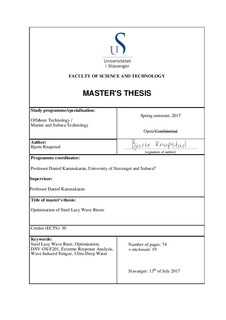| dc.contributor.advisor | Karunakaran, Daniel | |
| dc.contributor.author | Knapstad, Bjarte | |
| dc.date.accessioned | 2017-10-18T12:24:18Z | |
| dc.date.available | 2017-10-18T12:24:18Z | |
| dc.date.issued | 2017-07-13 | |
| dc.identifier.uri | http://hdl.handle.net/11250/2460841 | |
| dc.description | Master's thesis in Offshore Technology: Marine and Subsea Technology | nb_NO |
| dc.description.abstract | The objective of this thesis is to optimise the performance of an initial Steel Lazy Wave Riser (SLWR) configuration with regards to the combined loading criteria in the Offshore Standard DNV-OS-F201: Dynamic Risers. This is done by conducting large scale parameter variations for the configuration using the programming interface in the OrcaFlex analysis software. The study considers the implementation of SLWRs in ultra-deep waters, in conjunction with a Floating Production Storage and Offloading (FPSO) vessel.
Being connected to a spread moored FPSO in a water depth of 2800 meters, the riser configurations are analysed for typical extreme environmental conditions found in the Santos basin off the coast of Brazil. By analysing the vessel response for different 100-year waves, the worst conditions are determined in terms of the largest downward velocities experienced at hang-off point. These parameters are used in combination with a 10-year current to study the extreme response behaviour for the different configurations analysed.
From the design basis, an initial SLWR configuration is established and it is verified that it meets the stated design criteria for combined loading and the wave induced fatigue. This configuration is then subjected to parameter variations by altering the hang-off angle, total net buoyancy force and length of buoyancy section. A total of 75 different configurations are created and analysed under extreme environmental conditions to determine a better configuration in terms of the combined loading utilisation. The findings are presented and a comparison of selected configurations are given to better understand the effect of the parameter variations.
The optimisation results show that all the configurations meet the Ultimate Limit State (ULS) design criteria, and that the maximum utilisation experienced in the different cases varies significantly. With tension being the main contributor for the combined loading in these water depths, it is found that a combination of reduced hang-off angle and increased net buoyancy force will improve the performance of the configuration. From the optimisation study, the best configuration is determined and assessed for wave induced fatigue life. The fatigue results show an increase in fatigue life, which also reflects the importance of reducing the top tension.
The work presented in this thesis provides information on how different parameters for a SLWR in ultra-deep water affects the combined loading utilisation, and it is proven that this concept is feasible for use in conjunction with a FPSO in these water depths. | nb_NO |
| dc.language.iso | eng | nb_NO |
| dc.publisher | University of Stavanger, Norway | nb_NO |
| dc.relation.ispartofseries | Masteroppgave/UIS-TN-IKM/2017; | |
| dc.subject | offshoreteknologi | nb_NO |
| dc.subject | undervannsteknologi | nb_NO |
| dc.subject | offshore technology | nb_NO |
| dc.subject | subsea technology | nb_NO |
| dc.subject | offshore teknologi | nb_NO |
| dc.title | Optimisation of Steel Lazy Wave Risers | nb_NO |
| dc.type | Master thesis | nb_NO |
| dc.subject.nsi | VDP::Teknologi: 500::Marin teknologi: 580::Offshoreteknologi: 581 | nb_NO |
